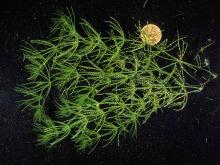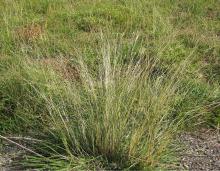Wildflowers, Grasses and Other Nonwoody Plants
Media

Species Types
Scientific Name
Hypoxis hirsuta
Description
Yellow star grass grows throughout the tallgrass prairie region. Imagine the thoughts of pioneers when they gazed upon these bright little lilies during stops along their westward journey!
Media

Species Types
Scientific Name
Potamogeton spp.
Description
Pondweeds are rooted aquatic plants with underwater leaves on long, flexible, jointed stems. Some have floating leaves, too, that are differently shaped. Missouri has about 10 species in the pondweed genus.
Media

Species Types
Scientific Name
Chara spp.
Description
These aquatic algae look like regular vascular plants. Chara has a crisp, gritty texture, a musky odor, and gray-green, needlelike structures that resemble leaves.
Media

Species Types
Scientific Name
Najas spp.
Description
Naiads are slender, narrow-leaved plants that grow completely under water and are rooted to the bottom. They never have broad, floating leaves or conspicuous flowers or seed heads.
Media

Species Types
Scientific Name
Ceratophyllum demersum
Description
Coontail, a common submerged aquatic plant, got its name from the crowded upper leaves, which make the stem tip appear bushy like the tail of a raccoon.
Media

Species Types
Scientific Name
Bothriochloa bladhii
Description
Causasian bluestem and the closely related yellow bluestem are both aggressive, weedy degraders of pasturelands that escape cultivation and endanger native habitats. Learn more about these Old World grasses, and please don’t plant them!
Media

Species Types
Scientific Name
Sorghum halepense
Description
Johnson grass is a native of the Mediterranean that is invasive in our country. It’s a weed that infests cropland and degrades native ecosystems, and heavy infestations are found in all the major river bottoms of Missouri.
Media

Species Types
Scientific Name
All true grasses (species in the grass family)
Description
Missouri has 276 species in the grass family, including well-known crop plants and our native prairie grasses. Distinguishing between the species can be difficult, but it’s easy to learn some basics about the group.
Media

Species Types
Scientific Name
Phalaris arundinacea
Description
Reed canary grass is native to Europe, Asia, and North America, and it varies quite a bit. Our native Missouri version, for instance, is quite different from the Eurasian type that has been widely introduced — and which has proven to be highly invasive.
Media

Species Types
Scientific Name
Bothriochloa ischaemum
Description
Yellow bluestem is a nonnative, aggressive, weedy degrader of pasturelands that escapes cultivation and endangers native habitats. It blooms in Missouri in late June to July, far earlier than our native bluestems.
See Also
About Wildflowers, Grasses and Other Nonwoody Plants in Missouri
A very simple way of thinking about the green world is to divide the vascular plants into two groups: woody and nonwoody (or herbaceous). But this is an artificial division; many plant families include some species that are woody and some that are not. The diversity of nonwoody vascular plants is staggering! Think of all the ferns, grasses, sedges, lilies, peas, sunflowers, nightshades, milkweeds, mustards, mints, and mallows — weeds and wildflowers — and many more!





















